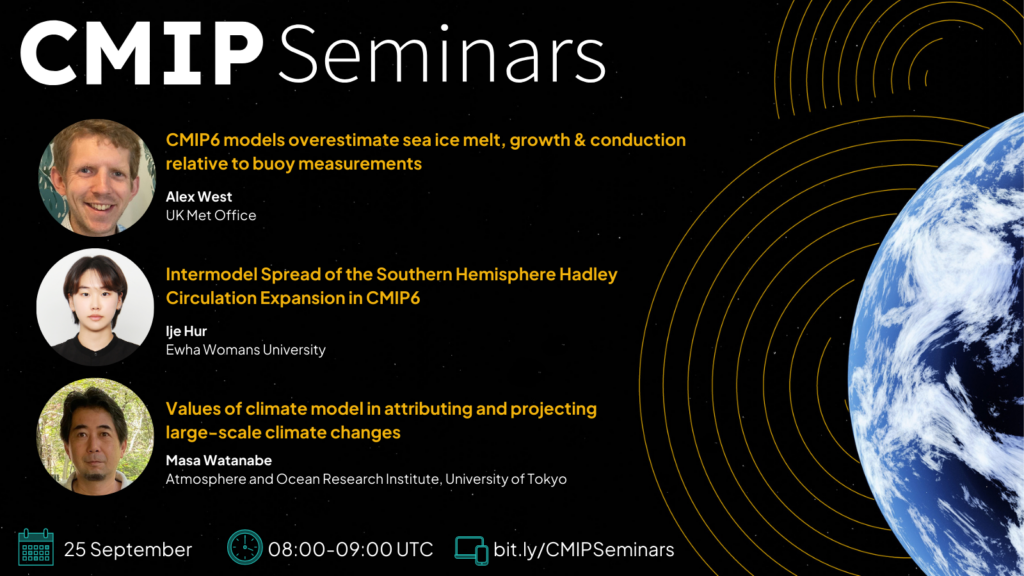
25 September, 2024 @ 08:00 – 09:00 UTC
Sixth session of the CMIP Seminar Series.

Registration
Click the button below to register. We’ll send out information on how to attend the seminars to this list a few hours before the event starts. Note that, if you registered for a previous event, you are already registered for all future events.
Speakers

Alex West Senior Scientist, The Met Office
Title: CMIP6 models overestimate sea ice melt, growth & conduction relative to buoy measurements
Abstract: The Arctic’s network of Ice Mass Balance buoys (IMBs) is used to evaluate fluxes of sea ice melt, growth & conduction in CMIP6 models, to better understand spread in sea ice volume in the historical period. Around 100 IMBs have been released in the Arctic Ocean since the early 1990s; these instruments measure ice surface & base elevation, and ice temperatures at 10cm resolution, allowing melt, growth & conduction to be estimated.
Model evaluation is restricted to the North Pole & Beaufort Sea regions, which are particularly densely sampled by the IMBs. 17 CMIP6 models from 9 institutes provide the required fluxes; the final 30 years of the historical simulations, from 1985-2014, are evaluated. The sea ice states of these models vary from very thick to very thin. As is predicted by theory, models with thin ice tend to produce higher melt, growth & conduction fluxes than those with thick ice. However the nature of the relationship varies, in some cases in a manner that is obviously physically consistent with differences in ice thermodynamics parameterisation.
Across the ensemble as a whole, fluxes of melt, growth & conduction are on average higher than measured by the IMBs, even as a function of ice thickness and snow depth. A variety of methods are used to ensure as close a comparison as possible between models & buoys, showing the model bias to be real.

Ije Hur PhD Student, Ewha Womans University
Title: Intermodel Spread of the Southern Hemisphere Hadley Circulation Expansion in CMIP6
Abstract: There is a large intermodel spread of predictions for Hadley circulation expansion in CMIP6 models, particularly in the Southern Hemisphere. We investigate the mechanisms driving the intermodel spread in SH HC expansion predictions. The intermodel spread is obtained by an empirical orthogonal function analysis on the SH HC trend patterns of 16 CMIP6 model simulations using the historical and Shared Socio-economic Pathway 5-8.5 scenarios. The first leading mode, showing a mean meridional streamfunction anomaly at the poleward SH HC extent, explains 49.73% of the variance and has a significantly correlates (r = 0.94) with the SH HC expansion. By analyzing the extended Kuo–Eliassen equation, we find the contributions of diabatic heating and eddy fluxes to model spread. The models simulating a relatively large SH HC expansion tend to show increased precipitation in the Southern Pacific Convergence Zone, reduced baroclinic instability in the subtropics, and an enhanced poleward shift of jet stream in the midlatitudes. This suggests that the uncertainty in the HC projection may be constrained by reducing the bias in the mean fields.
Co-authors: Changhyun Yoo, Sang-Wook Yeh, Young-Ha Kim, and Kyong-Hwan Seo

Masa Watanabe Professor, Atmosphere and Ocean Research Institute, University of Tokyo
Title: Values of climate model in attributing and projecting large-scale climate changes
Abstract: General circulation models (or global climate models, GCMs) and Earth system models (ESMs) are undoubtedly important tools in the present climate science, and information derived from the GCM/ESM simulations is critical in some occasions such as future climate projections. The GCMs/ESMs have continuously been improved during the past CMIP cycle, but the pace of the model improvement is not as rapid as we might expect, causing systematic errors in the mean state and processes to remain in many models to date. These errors hinder obtaining robust climate change signals in models, and therefore a comprehensive assessment of the future change associated with global warming, as was done in the IPCC Sixth Assessment Report (AR6), requires combining multiple lines of evidence that act to narrow uncertainties. Yet, some of the evidence relies on the ensemble of GCM simulations, implying that the value of climate models in robustly estimating climate change signals is not downgraded even in the presence of model errors. Credibility to GCMs is increased when they can reproduce better climate changes observed during the historical period. It is, however, not straightforward to measure the models’ reproducibility because observed changes are often the results of both externally forced climate response and internally generated climate variability. The separation is difficult with GCMs that contain systematic errors and therefore the attribution of observed climate change remains a challenge despite many attribution studies have been carried. As an example, I will introduce a recent community effort in attributing the observed large-scale change in the tropical Pacific sea surface temperature (SST) pattern over the past decades.
Recordings
CMIP6 models overestimate sea ice melt, growth & conduction relative to buoy measurements (Alex West, The Met Office)
Intermodel spread of the Southern Hemisphere Hadley Circulation expansion in CMIP6 (Ije Hur, Ewha Womens University)
Values of climate models in attributing and projecting large-scale climate changes (Masa Watanabe, University of Tokyo)
